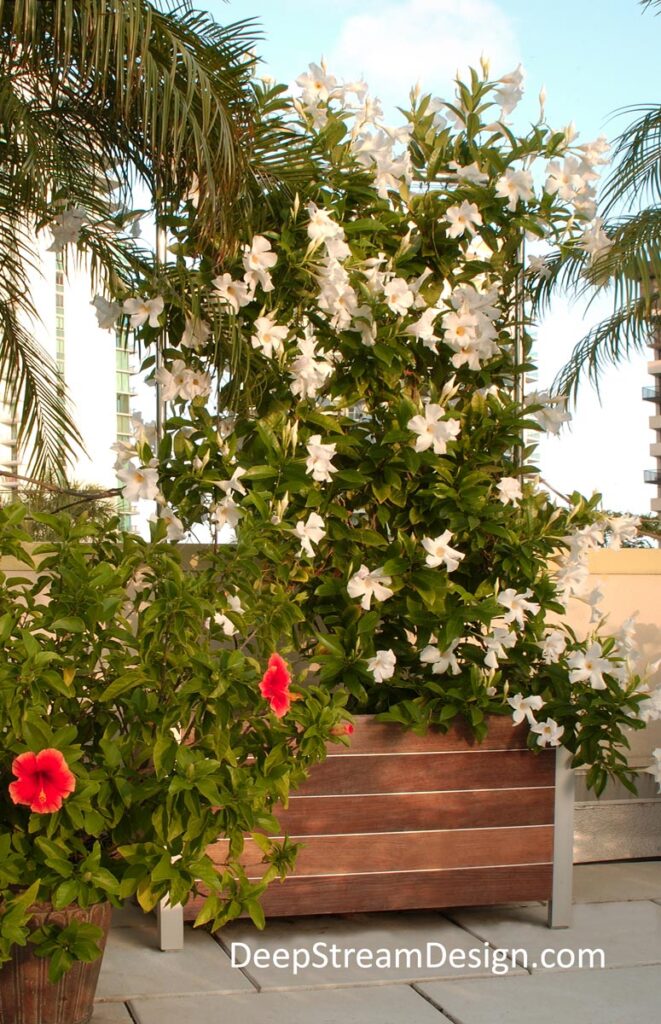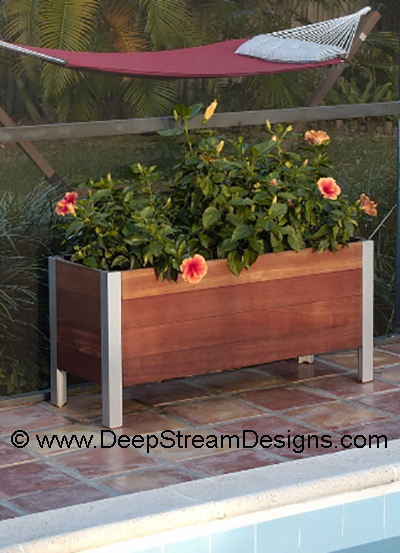Planter Selection not only takes into consideration the location of the planter and the requirements of the plants that it will hold, but selection should also consider the quality and environmental impact of the materials and construction details relative to your price-value expectations, and visual aesthetics.
Our goal for planters above grade in commercial and residential buildings is to avoid potential structural damage created by poured-in-place concrete planters or penetration of roof and terrace membranes.
After reading this comprehensive blog you will be able to select the right planter for your project, aware of how various planter designs, materials, and functions make it simple to choose the best solutions. If you’re a landscape professional, architect, general contractor, condo manager, or purchasing agent, this will help you avoid expensive and embarrassing career mistakes. Here is a link to some of the blue chip companies with whom we have worked to help overcome their challenges.
A shorter, less detailed article on Choosing a Garden Planter can be found by clicking here. To skip straight to the solutions we have created for our projects and thousands of others, go straight to the DeepStream Designs website.
Don’t bother reading this blog if you’re looking for cheap pots for short-term use that will quickly be thrown away. It will be a waste of your time. DeepStream Designs’ goal is to produce the lowest cost product over time for both our customers and the environment, which requires an upfront investment on our customers’ part and customer solutions with a Lifetime Structural Warranty and easy to replace parts on our part. We and our American craftsmen refuse to be part of the throwaway society created by planned obsolescence.
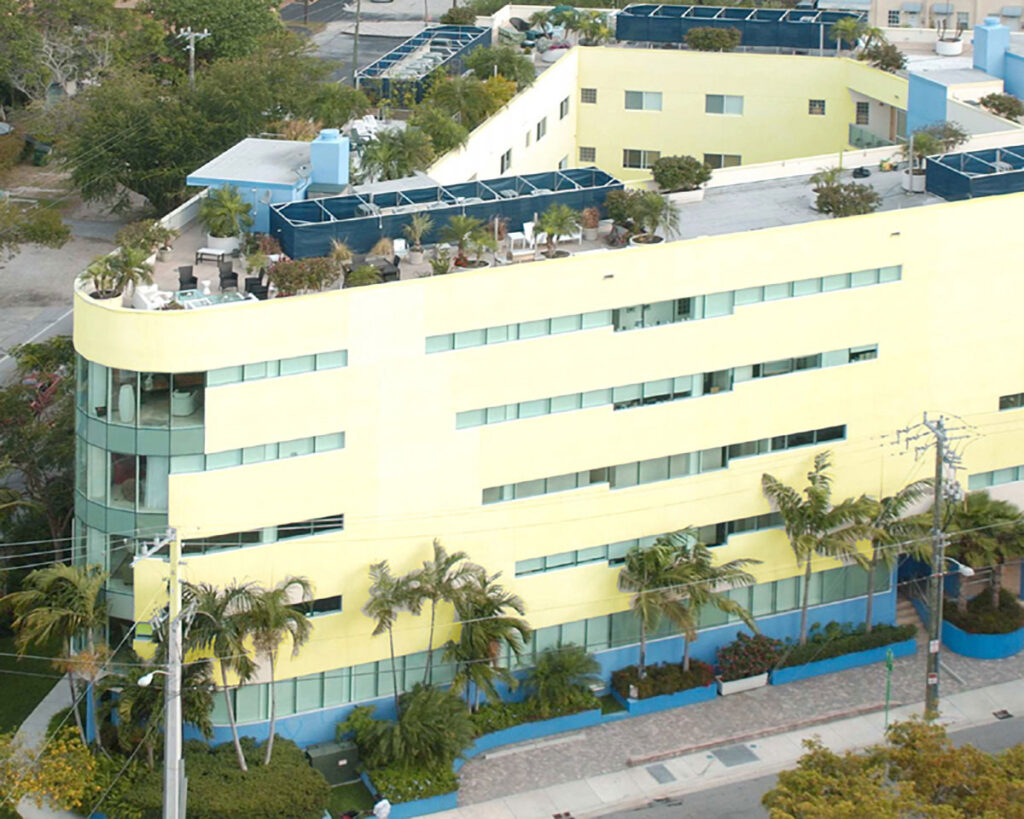
As we have seen in the tragic July 2021 collapse of the Surfside condo here in the Miami area, to achieve the benefits of green space on roofs, large planters must avoid the structural damage to commercial and residential buildings created by poured-in-place concrete planters.
In July, 2021, the planter selection comparisons found in this blog were substantially updated with long-term tests, new products, and new materials. The goal of this blog post continues to be allowing readers to make an informed choice when selecting planters by providing a detailed comparison of these factors from my experience as a planter designer and manufacturer, environmentalist, and my own customer as a building developer and general contractor.
As developers, avoiding structural damage to our building with poured-in-place concrete planters which can lead to expensive remediation was one of the main reasons we founded DeepStream in 2006 to make rooftop deck planters for our own condo building in Miami. The other goal was to minimize the total cost of planters over the lifetime of the building, as the wasteful short lifetime of carpenter-built wood planters requires a regular, costly replacement process.
To achieve this goal DeepStream products incorporate deceptively simple, aesthetically-pleasing, timeless design, which minimizes environmental impact through material selection, rugged construction, and replaceable parts using principles of Sustainable Design to maximize durability.
As I was developing a condo building in Miami, where my wife and I still live 15 years later, I wanted to create a livable rooftop with lush landscaping. Frustratingly, in 2004, we were unable to convince the city building department that green roofs were insulation in and of themselves, so we were unable to have a grass roof as you can now.
I realized, however, that the roof surface area of a condo tower was a much lower percentage of the building surface area than the walls themselves. Therefore I began a search for large lightweight planters that had a high ratio of surface area to weight to use both on the roof and on balconies.
As buildings settle, and all buildings do over time, cracks appear and then water runs along the lines of steel rebar used in poured concrete construction rusting them and causing the rebar to expand up to 20 times their original size, creating an effect called “spalling,” cracking the concrete. Correcting spalling is a very expensive and disruptive process. Stand-alone planters avoid this.



If you do have poured-in-place concrete planters leaking through a slab and along beams that can be reached from below, planter liners may not the right solution. There is a warranted solution that can remedy this that does not require digging up the mature landscaping in the planter and resealing the planter and then having it fail again in a few years. Though not inexpensive, it is far less expensive and less of an interruption to the residents than the first option.
We have used the services of Seal Wizard, which uses a patented process to remediate a leaking slab for a parking apron and pool deck. The company uses a special compound injected using a high-pressure pump and special hydraulic fittings that are drilled into the slab to intersect the crack from beneath the slab.
The two-part compound flows through cracks under pressure, displacing water until it reaches the top of the crack, filling voids along rebar and displacing the water upwards and out. Afterward, the fittings are removed and the small holes are patched, leaving the bottom of the slab or beams as new. Please contact Sheila at DeepStream for a referral at (305) 857-0466.
The issues with poured-in-place concrete planters aside, equally important for homeowners, restaurants, hotels, and commercial properties when selecting a planter is to find properly designed planters that avoid the very real costs incurred when landscaping dies, or planters fail in just a few years, wasting money, time, and effort, and disrupting operations. Perhaps even more important, dead plants and dilapidated pots or planters, being so highly visible to potential customers, look shabby and detract from your business or brand.

I write this blog through the lens of being my own customer, as we started building planters for our projects and have a long-term interest in creating planters with the lowest cost of ownership for our own projects, our customers, and the environment. Providing the optimum growing environment reduces landscaping, watering, and associated labor costs.
On top of those considerations was a desire to create a planter system that was more than a “just a planter,” one that avoided wasting valuable tropical hardwood with carpenter-built techniques that fall apart in just a few years, so that our planters could better meet the needs of and provide flexible solutions for our customers’ challenges.
To achieve those goals, my search led me to design unique planters using several materials and techniques to overcome issues I found with existing planters:

The Mariner Commercial Planter is a complete 3-part engineered landscaping system that incorporates proprietary anodized aluminum structural extrusions with an internal aluminum frame that supports an outer planter box of wood or maintenance-free, eco-friendly recycled plastic lumber, and a rugged 100% recycled plastic waterproof liner with advanced drainage.
In addition to promoting drainage, liners prevent the wooden boxes from rotting and prevent solar gain from steaming the root ball. They also hide labor-saving drip irrigations systems and wiring for lights.
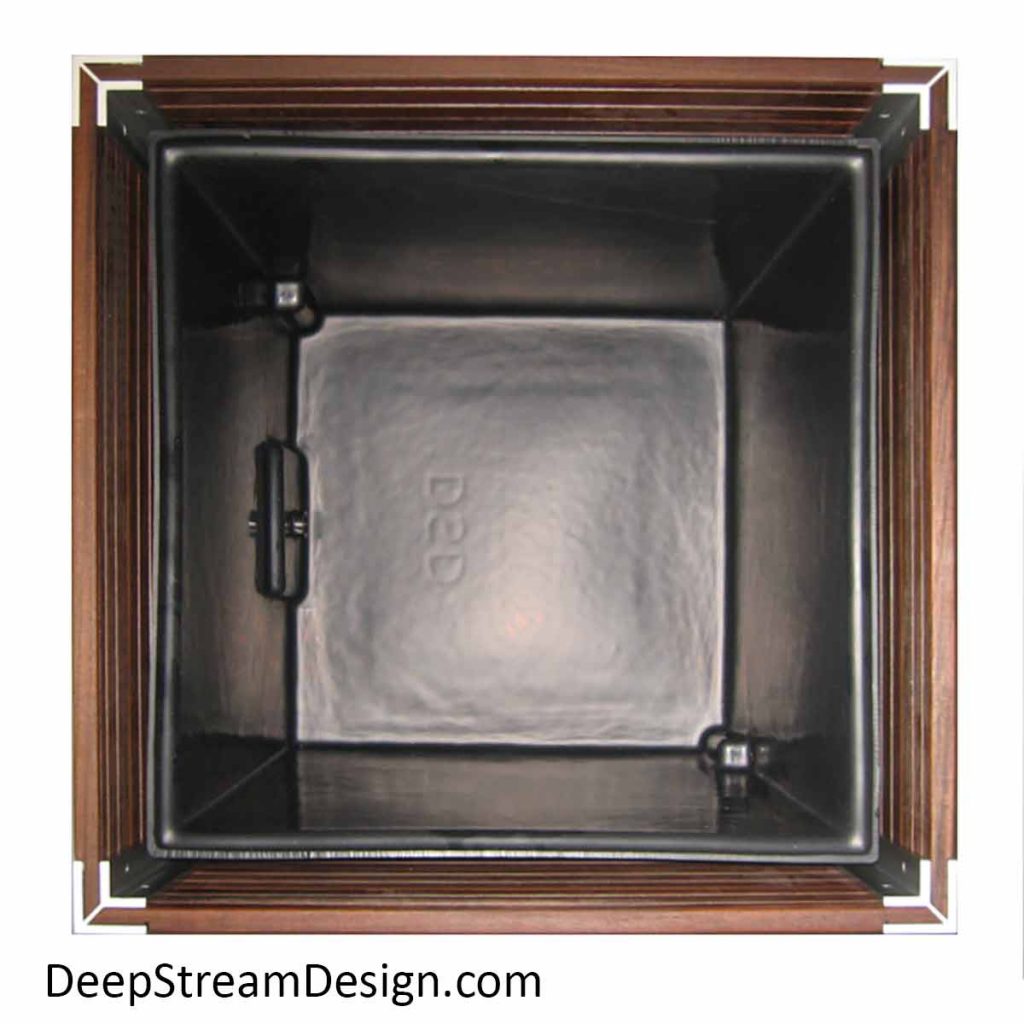

DeepStream’s Mariner planter integrates accessories that are engineered into the planter by design, not as an afterthought. These options include:
- Cost-effective multi-section planters of infinite length
- A “bomb proof” caster base, making even the largest planters movable
- Gates
- Trellises
- Benches
- Screen walls for privacy, security, and access control with no penetrations of roof decks or city sidewalks to secure them.


HDPE Food-Safe Planters, new for 2020, are a lower cost planter than fiberglass, and since they do not require molds, they can be built to any size you need. HDPE, like recycled plastic lumber, is the same material as milk bottles and cutting boards, so it is easily recyclable at the end of its long lifecycle.
It’s also more flexible than fiberglass, so it won’t crack. Since the material is a solid color throughout, it doesn’t show chips and dings in the same way as fiberglass. It is also resistant to graffiti, as it repels paint and can be cleaned with many paint strippers or sanded. Hidden aluminum caster wheel bases can be built in for mobility.

Commercial Marine Aluminum Planters are also new for 2020. DeepStream’s unpainted 5086 aluminum planters are the same marine grade as that used to build ocean going ships and yachts. This alloy is chosen for its ability to withstand years of commercial use in the ocean’s corrosive salt water.
Paint or powder coatings will fail in 3 to 5 years and flake off, requiring sanding or media blasting before being refinished. While more expensive to produce with a flawless exterior finish than painting, the natural sanded finish of the unpainted planters will develop a soft gray to dark oxide patina that actually protects the aluminum below. Bare aluminum can be refinished by sanding, but it’s actually better to let the oxide patina naturally as it provides a protective finish.
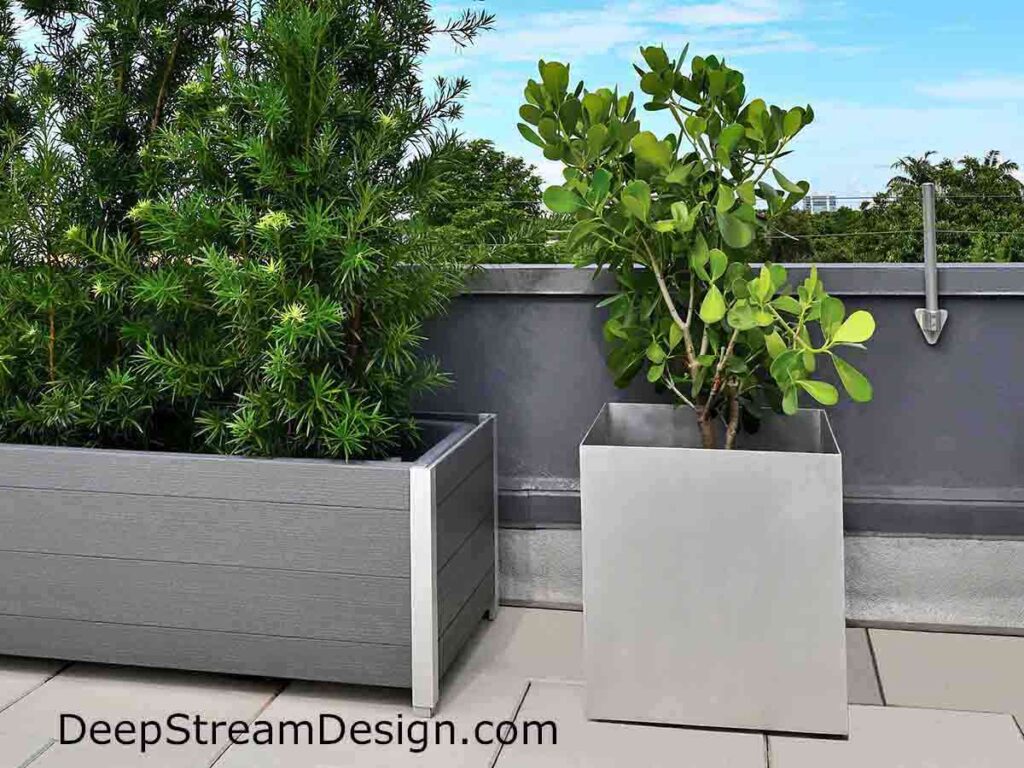
Planter Design driven by customers’ operational challenges and response to environmental imperatives.
We did not set out to become a manufacturer, we just wanted to fulfill our needs for our new condo project. Then one visitor wanted some of our planters, one thing lead to another, and ultimately we became a custom manufacturer.
To keep things simple, and our connection with our customers, we only sell factory-direct with volume discounts that represent our reduced setup costs. There is never a design fee, as we love to solve challenges for our customers, whether it’s a single one of our many custom fixtures for a rooftop deck dog park, restaurant, or pool deck, or hundreds of fixtures for hotels, apartment buildings, and theme parks.
15 years later, we find that there are even more urban gardeners, hotels, restaurants, commercial buildings, and condo boards that are truly interested in making high-density urban environments more beautiful, more private, and more eco-friendly with low-lifecycle-cost sustainable green roof, living wall, patio, and balcony projects.

Residential and office condo towers are increasingly prevalent in dense urban and coastal areas, and contribute to the formation of “heat Islands” and global warming by adding heat-retaining surface area, unless they can be landscaped.
According to the American Institute of Architects (AIA), buildings are the leading source of greenhouse gas emissions in the United States. According to estimates in the AIA’s Architects and Climate Change report, buildings represent 48 percent of carbon dioxide emissions, with transportation and industry representing 27 percent and 25 percent respectively.
The Green Roof movement is great, landscaping our penthouse roof lowered our electricity bill by 20%. However the ratio of wall-to-roof area is much greater on high-rise buildings. If Architects designed balconies with drainage and water spigots built into their clients’ high-rise buildings, it would make it easier for residents and offices to help offset their impact to a far greater degree, both in terms of cooling and exchanging oxygen for carbon, and absorbing other pollutants.
While lots of great looking pots exist, large surface area planters were scarce. Also, as I was soon to learn, pots had serious drawbacks for use up on windy buildings, especially on sunny south and west facing exposures due to solar gain of single skin pots and planters stressing roots. As I proceeded through the sourcing process, I eventually assembled a list of attributes that I felt was important in these planters:
- Large surface area
- Aesthetically pleasing
- Variety of dimensions and materials
- Durable, with a low lifecycle cost
- Low impact on the environment
- Lightweight
- Thermal protection for roots
- Drainage control
- Stability in high winds
- Easy to water
Ultimately, I could not find what I was looking for, so I started my own design and manufacturing company to create customizable planters and created nine proprietary marine-anodized aluminum extrusions, no paint or powder coating to fail, including the Mariner leg used as our trademark, to address all these issues.
Our extrusions save valuable tropical hardwood and rain forests by containing the tremendous forces created by the endless wetting and drying cycles that wood planters go through outside. They also allow for the use of recycled plastic lumber (RPL) as our extrusions allow for the linear expansion and contraction of RPL created by temperature change. Our engineering and proprietary trademark marine-anodized aluminum extrusions are designed to make it possible to offer a Lifetime Structural Warranty when fiberglass planters only offer 1-3 years, and carpenter-built wood planters only last 3 to 5 years here in Miami.



On major projects using the services of a Landscape Architect is highly recommended to shortcut the process of creating a pleasing space integrated with your lifestyle and goals. The fees you pay a Landscape Architect on a medium to large size job site will save you money in the long run and your installation will look better from the start..
Keep in mind that, as in any profession, many practitioners have found what they consider to be tried and true practices and may not have kept up with changes in the industry, so you need to be informed. A true professional will welcome your respectful input because the ultimate goal should be your satisfaction. Don’t be intimidated; share your ideas and feedback with them.
Ultimately many architects, developers and general contractors don’t understand the long-term cost of planters as they design, develop, spec, build, and walk away, leaving condo boards or owners with the true long-term costs of their decisions that will show up after the warranty period for their part of the project has expired.
Every month we turn down offers from contractors to quote projects that architects or engineers have designed that we know will quickly fail and tarnish our good name. If we can’t talk directly to the person responsible for the planter selection about the issues we see with their design or material, we have no other choice.
We built our company on solving challenges, not building disposable products that cost more in time, labor, mess, and the frustration of doing it over again. Build it right, build it once. If you don’t have the budget for what you need to achieve, then our considered advice is to cut back on the scope of the project, or don’t build it at all.
If you’re a homeowner, you may be unfamiliar with many of the resources I list, as they are sources used by Landscape Architects; however, the quality of products found using these resources are of a professional grade, and thus the impact on the environment, and the lifetime cost of these products is far lower than many “consumer” products that literally define planned obsolescence and a harmful throw-away society.
Planter Selection Challenges and Solutions:
Foremost among the problems I faced in sourcing large planters with substantial surface area was finding any large planters at all, let alone contemporary planters in a variety of styles and sizes that provided protection from soil overheating on south-and west-facing exposures, water drainage control, stability in high winds, ease of watering, and portability.
Large surface area:
Large planters, especially attractive ones, were surprisingly hard to find. While there are lots and lots of pots of various sizes, they really do not provide the large surface area to plant trees, hedges or vines necessary for the shade and privacy screening that I wanted for larger areas and rectilinear balconies.
Aesthetic:
Each type of material used in construction has its advantages and disadvantages, which vary greatly with construction and design.
Planters that I found with large surface areas looked more institutional or commercial in design and were more appropriate for a parking lot. They simply did not possess the appropriate design attributes of architectural planters for a residential project. Restaurants building sidewalk cafes and even expanding into their parking lots use our high-quality, easy-to-maintain products to reflect on the quality of the food and atmosphere that they are serving up inside.
Variety of dimensions and materials:
Again, none of the ready-made large planters that I was able to find were available in custom sizes or material to fit all the niches and variety of areas that I needed planters for. That’s why we set up our shop so that our craftsmen can efficiently build to any dimension an never charge a design or custom fee for a customer’s solution — whether it’s one planter for a home owner or 100 for a major development. Due to the modular nature of our design and short lead times there are no expensive change orders at the end of the project when the as-built dimension don’t match the architect’s drawing, preserving budgets and reputations.
While there may have been a choice of color, there really was not a choice of materials that would impart varying but compatible looks as one finds in pots. In Landscape Architect terms, these large planters fall under the “site amenities” category and are really more appropriate for streets, parks and parking lots.
Fiberglass can crack and only comes with a 3-year warranty at best. Ceramic and concrete are not waterproof, and some concrete planters have steel re-bar at their core. Steel, which expands to 20 times its size as it rusts, cracks the cement, leading to complete failure. If a concrete planter is appropriate for your project, ask the manufacturer to add Xypex®, as used to repair dams, to the mix before construction to retard this process for as long as possible.
If you do have built-in, poured-in-place concrete planters leaking through a slab and along beams that can be reached from below there is a warranteed solution that can remedy this that does not require digging up the mature landscaping above. Feel free to contact Sheila at DeepStream for a referral to Seal Wizard. (305) 857-0466.
Issues with Concrete Planters
Concrete planters, while great as security crash barriers outside a building, are very heavy to take up elevators and stairwells, and they are just as much work to remove. You may need a crane.
There are some relatively lightweight concrete planters on the market now, though still heavy, that may do a better job if they can be adequately waterproofed. Avoid planters with interior steel armatures and only buy cement planters that are reinforced with glass fiber in the mix known as GFRC planters. A detailed article with more information on glass reinforced concrete planters (GFRC) can be found here.
The ratio of surface area to weight, and lack of controlled drainage limits large concrete planters to the ground. Light color cement planters of great mass offer some protection from solar gain, although they hold heat well into the night.

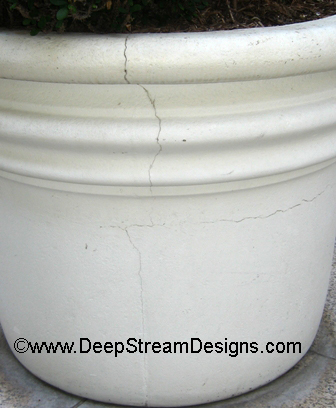
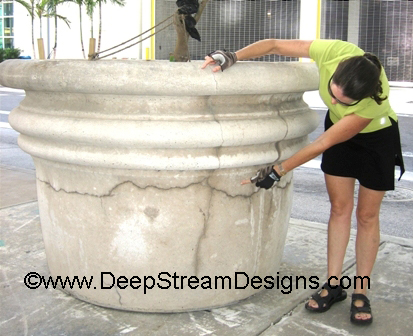



Planters that have no means of drainage control leave a mess.
Issues with Ceramic Planters
Large ceramic planters have some of the same drawbacks as concrete, although thinner walls make them lighter and more fragile, at least they do not have steel at the core. While they provide some protection from solar gain through evaporative cooling when wet, more than a couple of hours of sun will dry them out. There are no large surface area ceramic planters that I am aware of.
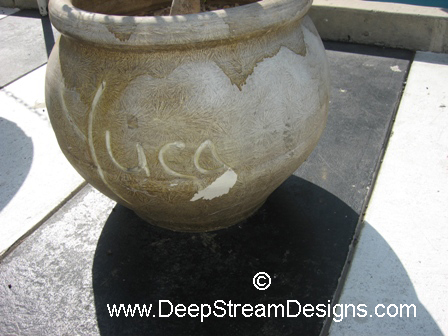


Ceramic planters should not be painted, as they will peel immediately.
Issues with Carpenter-Built Wood Planters
Initially I was drawn to the wood planters you see at street cafés all over Europe, but every planter I saw was falling apart. With my experience in yacht maintenance and rebuilding, including classic plank-on-plank varnished hull wooden sailboats, I could see that existing wood planter designs were not built to last for more than a few years. DeepStream was in fact created by a sketch of a wood planter that I did while enjoying espresso at a sidewalk cafe in Milan that was delineated by this typical decaying wood planter that you see all over Europe.
Long wood planters using modular construction make custom adaptation very economical, so I was determined to engineer a system that would overcome any shortcomings. Furthermore, given the need for lightweight planters for rooftop gardens with a beneficial weight-to-volume and strength ratio, nothing beats wood except recycled plastic lumber.
Available wood planter construction techniques fastened wood to wood, and planters would tear themselves apart with the expansive forces that wood exerts through repeated wet and dry cycles. Think of a wooden floor when it gets wet and buckles; that’s the wood expanding across the grain.
I engineered DeepStream wood planter’s trademark Mariner marine-anodized aluminum corner extrusion to contain the forces of the wood as it expands and contracts and allow it to move vertically within the slot, not split.

For centuries, wood dowels have been inserted into holes drilled into rock, then soaked with water. The expansion force of the wood is thus harnessed to crack blocks off marble and granite for construction, even though the blocks are hundreds of times thicker than the thin wooden dowel.
Since every wooden plank is cut from a different part of the tree, maybe even different trees, it has its own differential rate of expansion and warping when wet. This makes dimensional stability using standard wood-on-wood construction in two dimensions impossible to maintain over time, and shipbuilding techniques are far too costly for planter construction. In addition, most wood planters lack adequate isolation from the soil and the deck or sidewalk, which promotes fresh water rot.

New wood planters constructed by traditional carpenter methods are already rickety and falling apart. This does not reflect well on this restaurant, and they replaced it with ceramic pots a year later which, since this was the sunny side of the building, killed the plants with solar gain and this branch of a chain restaurant ultimately failed.

Traditional carpenter-built construction warping after just a few months.

Horizontal to vertical separation pulling fasteners out, panels separating.

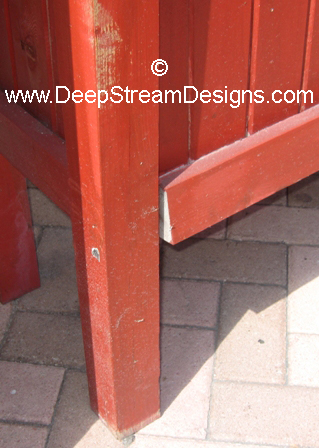
Raw wood feet on deck absorb water.


Vertical wood grain splits, warps, & rots

Vertically exposed end grain, and non-tropical hardwood quickly succumbs to rot and splitting, even using heavier bolted construction
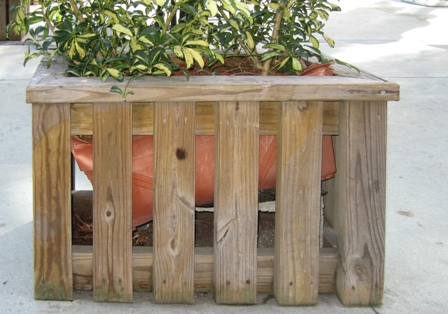
Unsupported and exposed liners are problematic and unsightly. They clearly do not attract the attention to quality that you want your restaurant or business to stand for. You are better off having no planters at all.
While wood will go grey over time, just like your teak garden furniture, unless you spend time oiling them often, never varnish wood planters. Tropical hardwoods have been used for centuries for shipbuilding, boardwalks, docks, etc. If you like the character that time imparts to wood, as I do, a planter constructed using my techniques can last for decades and not waste this valuable and diminishing precious resource.
DeepStream Designs horizontal planked tropical hardwood planters are a complete system constructed with trademark marine-anodized aluminum legs, no paint or powder coating to fail. An aircraft aluminum inner frame supports the waterproof inner liner equipped with advanced drainage solutions and anchors accessories like a trellis or casters. The replaceable HDPE plastic feet isolate the aluminum from wet decks and soil.
The rugged waterproof liners are 100% recycled food-safe LLDPE plastic, properly supported, easily watered, with advanced drainage. DeepStream planters can look good for decades providing the lowest cost of ownership over time; in fact, they have a Lifetime Structural Warranty
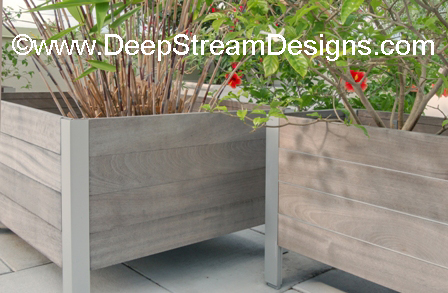
DeepStream’s commercial wood planters with their strong aircraft aluminum inner frame are highly adaptable and perfect to anchor rooftop screen walls, without the need to penetrate the roof membrane, for privacy and wind breaks in urban areas. They allow you to add protective glass screen walls and gates to control access, quiet noise, and extend the outdoor dining season for restaurants with patios.
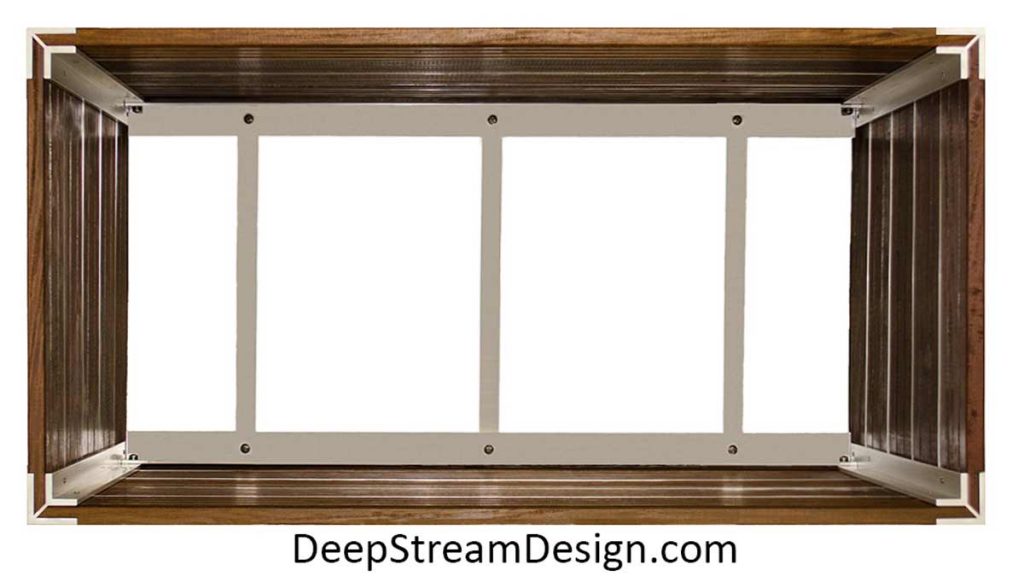
You can see how easy it is to refinished DeepStream wood planters in this detailed blog article.
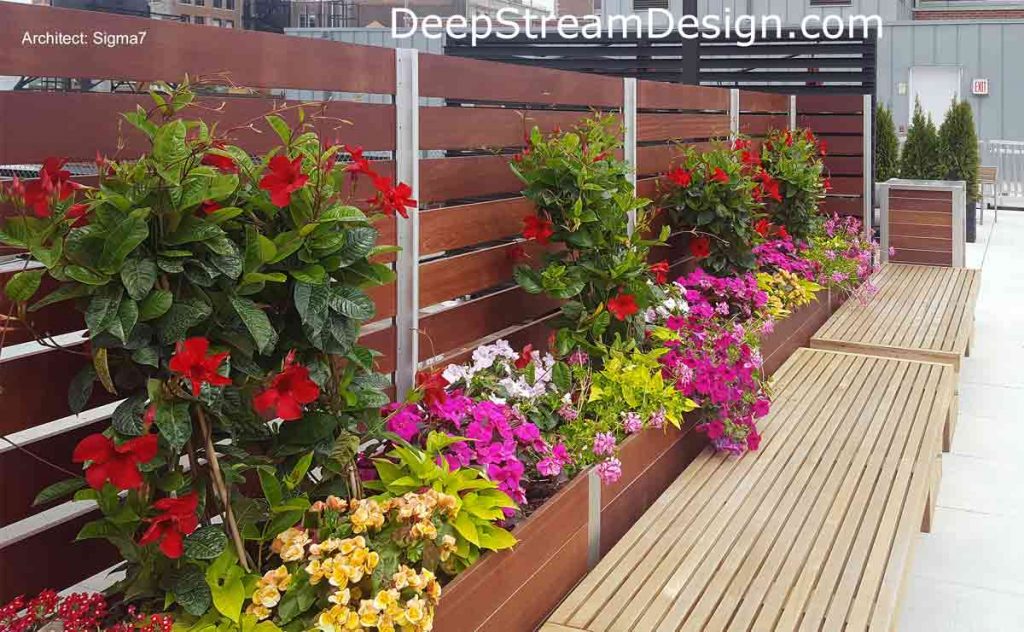

Issues with Plastic, Fiberglass, and Foam Pots
Plastic and resin can be excellent materials if the materials incorporate UV stabilizers. High-quality fiberglass resins should be able to last for at least 10 years, but even then the surface will get chalky over time. Fiberglass can be waterproof if the proper marine resins are used or a barrier coat has been applied, but like resins and plastic, it will develop a chalky surface over time.
Proper marine resins and barrier coats are very expensive. If a Fiberglass pot is cheap, it will not last — but just because one is expensive does not mean it is well made. Fiberglass is brittle and prone to cracking as roots push out. The best warranty for commercial Fiberglass Planters in the industry is only 3 years. Personally, I really like the ones that incorporate materials such as copper in the epoxy resin so that the patina improves over time.
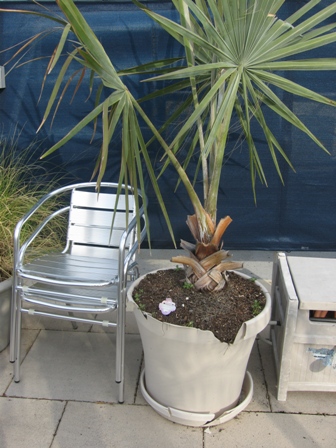
The major problem with all these pots in a sunny location is the lack of protection from solar gain, even more than than size, shape, and longevity.
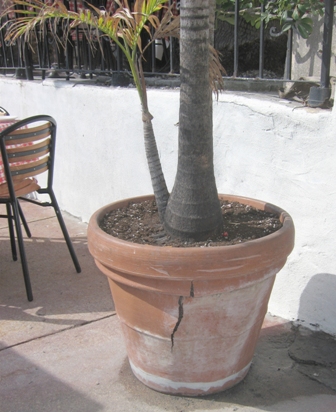
While there are many cheap plastic pots from home stores, I have never seen one large enough to be called a planter, and I can’t resist a word of caution. All of those cheap pots are too thin, contain no UV filters, and they quickly get brittle and break down. Many have painted exteriors that will soon fade and peel.
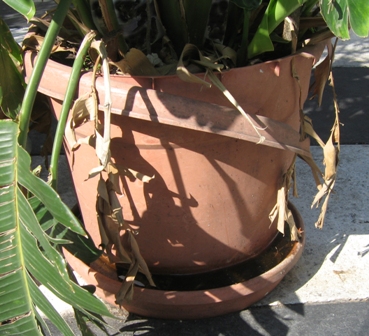
One particular series of plastic pot found at a national home store chain actually has a two-part construction that can fool you into thinking that they are of higher quality than they actually are. After a couple of months, they separate and the thick top rim falls off. Others are constructed of cheap foam covered with other materials, which quickly break down, and fall apart.

While okay if shaded, another shortcoming of plastic pots, aside from a short life, is that available pots are too small for larger plants and the taproot grows out of the hole on the bottom, ripping the pot and making it unstable. Note the surface degradation of the foam core plastic pot, even in the shade.
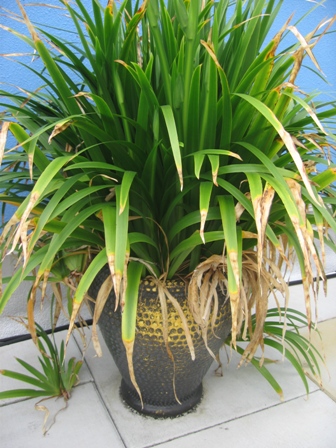
Just getting some of the plastic and foam core pots from the large home store back home without breaking proved impossible. Their design and construction was totally inadequate, sacrificed in the quest for the lowest initial cost to lure in suckers like me!
When I calculate the time and effort expended to select, buy, return, buy, return for credit, and then start the process over again, the cost of that lesson was very high indeed. And that is without all the hassle and mess of planting and unplanting. So much for value at the low end of the spectrum.
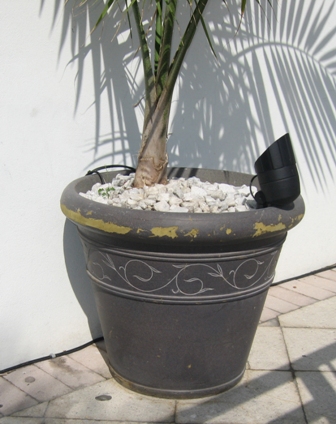
More examples: relatively expensive foam core pots, above, show typical surface degradation in just a few weeks.
If you are looking for an attractive, lower cost planter that will stand up to the hard knocks of life on the streets, whether for use at home, your restaurant, or commercial business, DeepStream’s customizable HDPE Food-Safe Plastic Planters, think cutting boards and recycled milk bottles, might be just what you are looking for.

Less expensive, softer, stronger, and more flexible than fiberglass planters, they come with the same 3-year warranty. Unlike fiberglass, they are also environmentally friendly in that HDPE planters can be recycled again easily at the end of their long life.
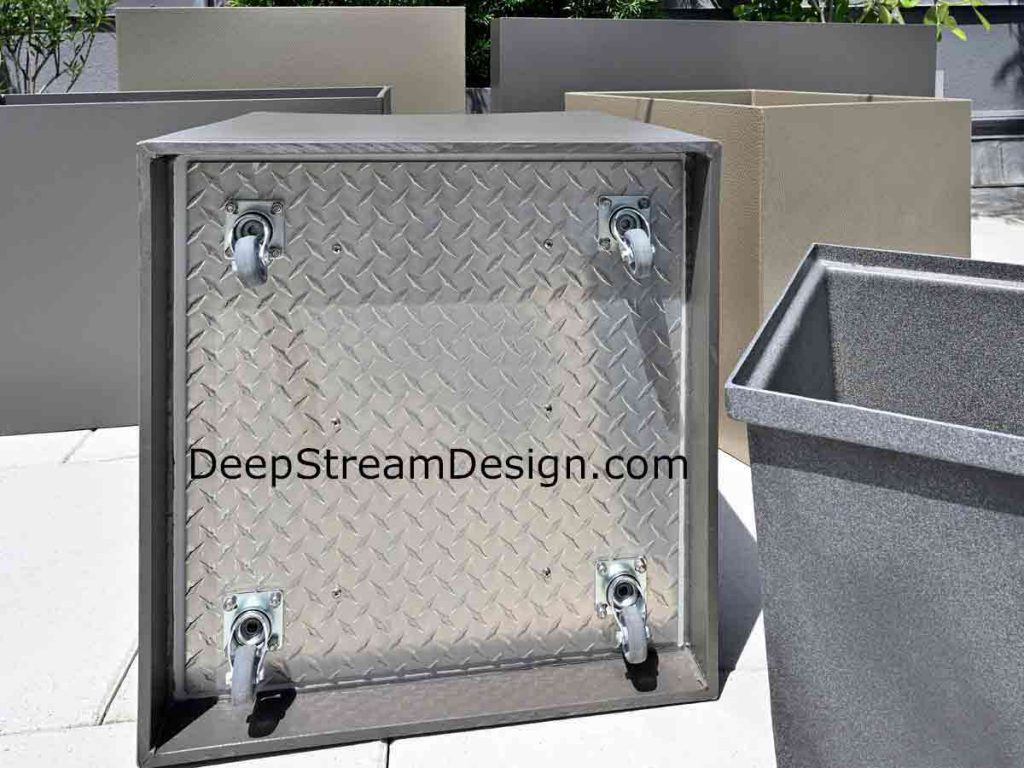
HDPE is a solid color throughout so Food-Safe Planters do not show scratches in the same way fiberglass or painted metal planters do. You can use a random orbital sander to effortlessly create a unique new finish.

Issues with Fiberglass Planters

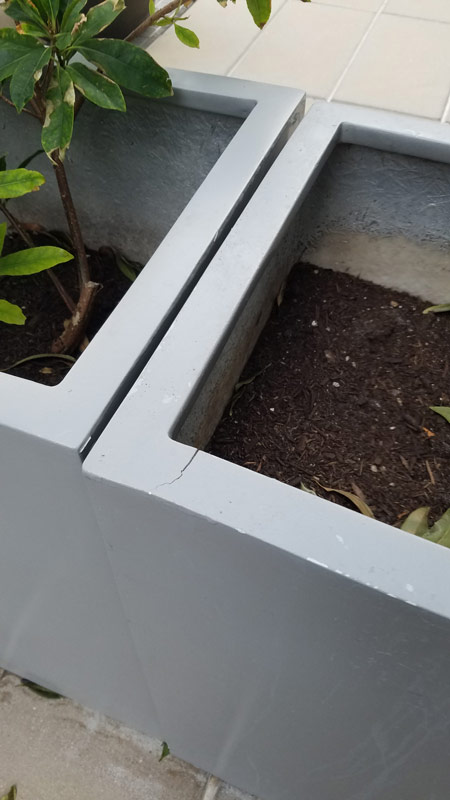



Contrary to popular belief most fiberglass construction is very prone to breakage.
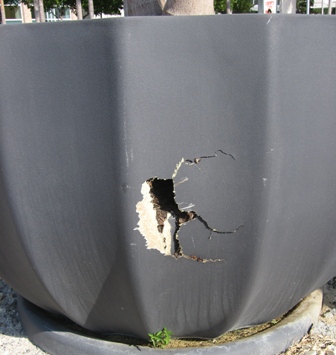
While most fiberglass planters are light, at the expense of strength, they may not be durable enough for certain location. Currently most fiberglass planters manufacturers are competing on price, with Indian and Chinese imports skimping on materials.
NOTE: Most of the fiberglass planters built in India, China, and even the US only carry a warranty of 1 to 3 years. DeepStream has a Lifetime Structural Warranty on the planters built with wood or recycled plastic lumber.
More information on quality Fiberglass Planters can be found in this article.

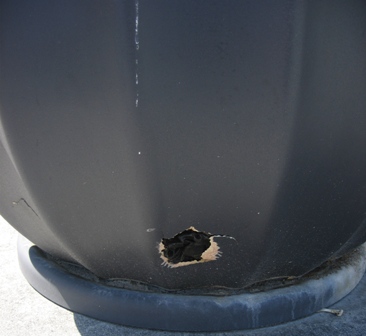
In addition, fiberglass planters are almost all single-walled and prone to solar gain. White or light-colored ones would be better in sunny locations. They do not have drainage control, nor do they hide drip irrigation lines. The large expensive ones above are installed in Miami’s downtown area, and while shaded by buildings, they are not really rugged enough for the streetscapes in which they are installed, nor do they have much surface area. Believe it or not, these planters are just 1/8″ thick painted skins of chopped fiberglass sprayed into a mold.
Issues with Metal Planters
Metal planters have various issues depending on the metal and the design. There are very few large surface area metal planters, and many forms inappropriate for windy locations. All metal passes solar gain rapidly and is not appropriate on long sunny south and west exposures unless there is a separate liner inside.

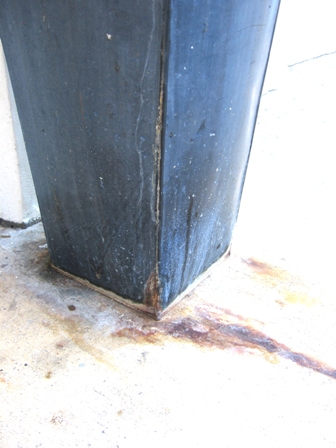
Metal planters leaking with rusty seams and rust through pin holes
Steel, iron and all forms of ferrous metal rust, including stainless steel. Corten steel looks great, but can leave stains as it ages. Cast aluminum and bronze can have great longevity depending on the alloy, but painted or powder coated they look terrible within three years. Zinc and copper patina nicely, but the seams will soon leak if there is no liner. Again, there are very few large surface area metal planters, as the metal is thin and non-structural.
3/16″ or 1/4″ marine grade 5086 or 5083 aluminum welded from the inside with proper rod, are incredibly strong and long lasting. Aluminum is the best choice of metal if its silvery finish works for your design criteria.

DeepStream builds custom aluminum planters to any rectilinear dimension using yacht building techniques. While the natural random orbital finish is a little more expensive, as it must be blemish free, it lasts for decades and is easily refinished.

While aluminum is easily painted or powder coated, be aware that, like fiberglass and every painted metal, scratches will show and you will have to blast and repaint them at least every 5 years if not sooner which is a lot of work since you need to replace and replant to do so properly.
Thermal Protection
From the plants’ point of view, thermal gain is as deadly as over- or under-watering. Pots, and most existing planters, also lack insulation qualities to protect the soil from solar gain. On a sunny 80º day, the sun can heat a dark single-layer pot to a surface temperature of 120º, and on a 90º day, the surface temperature can measure 140º or more, with the soil measuring 110º+ on the sunny side of the pot.


Within minutes of moving a fiberglass pot into the sun, the surface temperature climbed to 125 degrees on a 84-degree day, while the “liner within a planter” concept in the wood planter behind it keeps the soil no warmer than the temperature of the air.
No matter how much water we gave plants with hot soil, they didn’t do well. Pulling a plant out of a dark pot I found that the roots were literally being steamed! Unless there is a thermal break between the wall of a planter and the container for the plant, the solar gain is transferred to heat the soil. A proper thermal break will keep the soil no warmer than ambient air temperature and prevent both thermal shock and steaming the root system.


These newly planted palms already show signs of stress in limited morning sun. The edges of the leaves turn brown and overwatering rots the heart out of the palm closest to the sunny side so it is lost. Sea Grapes are much heartier, but will eventually succumb.

Only true low solar gain Low-E glazing, which is expensive, can block solar gain. Tinted glass is not enough on south- and west-facing exposures as you can see from these plants dying on a balcony and on the streets.

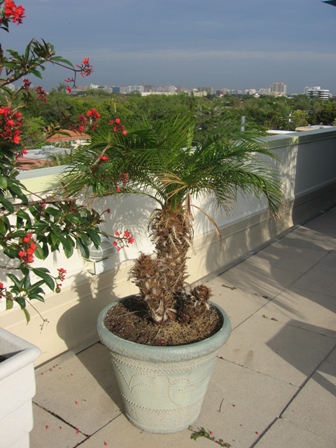
Even the browning palm (above top) in the ceramic pot, which has some measure of evaporative cooling when wet, suffers heat stress. The Robellini palm (above bottom) had no chance of survival. It has lost the two east facing trunks even though the fiberglass pot is in the afternoon shade of the parapet wall.
If you are using a single wall planter in an exposed sunny location and not getting good results then try to place it behind a barrier to solar gain as you see in this picture.

In the photo above you are looking southwest, so the building shades the planters in the morning, then full sun for about two hours, and then the low parapet shades the planters all afternoon.
Drainage control
Drainage control is important for several reasons:
- If planters do not drain properly, plants drown or develop root rot.
- If drainage is too easy, then water is wasted, which can be problematic when faced with water and/or time restrictions and nutrient wash out.
- Very few condo, converted loft or apartment buildings have drainage built into the balconies for planters or pots. We build trays to catch overflow that will evaporate without staining the deck. Having dirty water overflow from balconies and run down the side of the building or drop onto unsuspecting pedestrians and autos is usually not an option, and may be a violation of your condo rules as well as local city codes.
Condo Boards and building management are understandably reluctant to let residents have more than a pot or two outside on a balcony that can be brought in when it rains. While rooftops generally have drainage, it’s not usually where you need it, so they too have issues when creating a landscaped or green roof, even on a limited scale. We make planters on hidden casters that can be easily moved in under the balcony roof if your expecting torrential down pours we get here in Miami.
Drainage that is limited to a hole on the bottom, even covered with drain board and filter geotextiles, is especially prone to quickly repeated blockage that requires a lot of effort to restore. Good drainage starts with selecting the proper soil or planting medium.
For more detailed information on Planting Mix Vs Dirt read this article.
DeepStream addresses the issues with a 3-part drain pad that helps prevent roots and loose soil from blocking the drain holes and waterproof plastic liners have a threaded drain hole to attach drain hoses to direct water to a desired location.
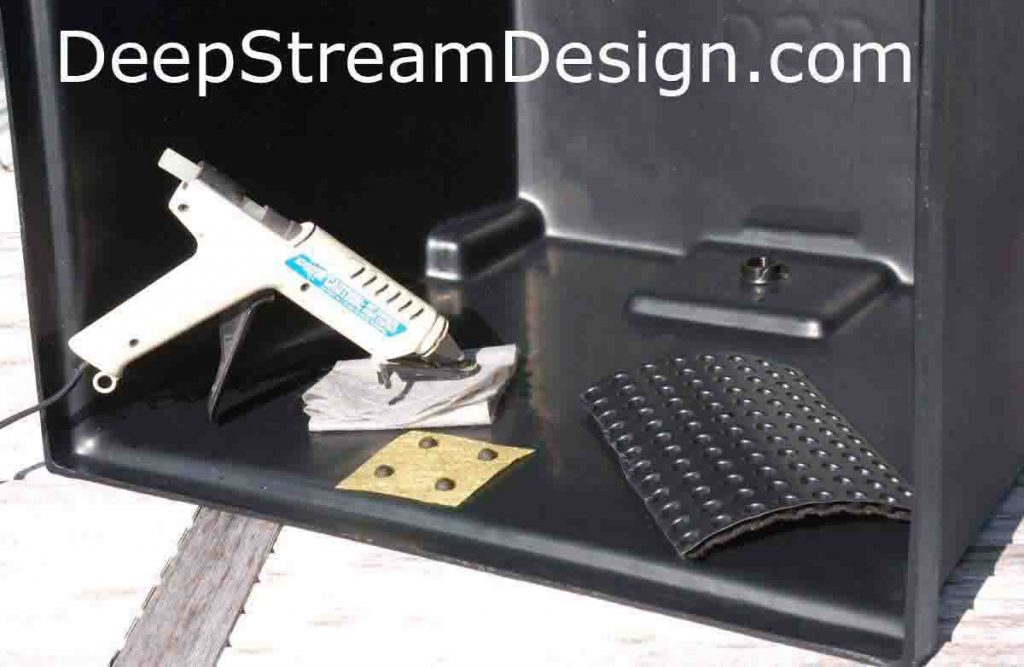
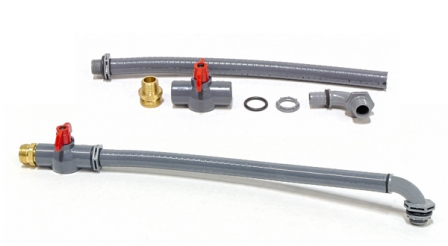
For more detailed information on how to best install planter drainage click on the following link for much greater detail: Garden Planter Planting Instructions.
Ease of watering
This challenge is more complicated than it initially appears but easily solved with DeepStream planters, liners, and drip-irrigation:
- First there is the issue of meeting watering schedules imposed by many municipalities, which may include watering at night.
- Watering large planted areas, or a great number of planters, with a hose is very expensive in terms of time.
- Many large planters can be landscaped with plants that have varying root depths.
- Planters that have a reservoir system only water to one depth, so planting flowers or bushes to surround trees is impossible without additional water sources. Even then the deeper-rooted plants can be over-watered and drown without great care in watering and plant selection.
- There is also the challenge of providing automatic watering systems without interfering with the aesthetics of the overall project. None of the planters designs shown above have a way to hide drip irrigation lines except DeepStream planters.
Low lifecycle costs, low impact on the environment:
These two issues really go hand in hand. Most developers want to create a “look” without costing a lot of money because the object is to sell the project for the most money while spending the least amount of money delivering that “look” so that profit is maximized. Resident owners may be limited by their budget but are, in general, looking for the lowest possible cost over time.
Quality almost always delivers the lowest cost over time. A well-made product that costs more, but last three times as long costs less money over time and exacts less of a cost on the environment. It also takes far less effort on the purchaser’s part, reducing acquisition and delivery costs, as well as freeing up resources for other uses. The decades longevity of our planters makes our them especially popular in urban areas like Manhattan where getting condo or co-op permission once is hard enough.
Often the cost of the product is confused with quality. The quality-cost equation comprises not only materials and construction, but also thoughtful design, careful purchasing, manufacturing, distribution, and sales cost. While two planters of equal aesthetic appeal and surface may cost the same amount, to truly evaluate value you need to compare the longevity of the design and material.
The lifecycle cost of a product greatly affects its environmental cost. Every material used in construction exacts a toll on the environment. I’ll not argue the relative merits of plastic over fiberglass, or concrete over wood, or aluminum over steel. Figuring out the true costs of the energy used by each process, the damage to the earth, and the recyclability of each material is beyond the scope of this forum.
In general terms, products will have a lower impact on the environment if:
- They are aesthetically pleasing, but not trendy, so that you can enjoy them for a long period of time;
- They have a modular design, constructed with replaceable parts so that they can be easily repaired instead of discarded should they suffer a mishap;
- High-quality, long-lasting materials appropriate for the intended environmental conditions are used in construction;
- They are made from distinct materials that can each be easily separated and recycled. You can get more information on Recycled Plastic Lumber and the Environment in this article.
- They use materials from renewable resources;
- The company you purchase them from invests more back into conservation than it takes from the environment.
According to the Yale School of Forestry, while estimates vary, it is thought that between 30 and 50% of all certified Tropical Hardwood shipped into the United states has been “Greenwashed,” meaning that shipments have been provided with falsified and counterfeit documentation. In some countries like Peru, it’s estimated that 90% are illegally logged, devastating their Amazon watershed. For more information click here: “Greenwashed” Timber and FSC certification
DeepStream makes it easy and cost effective to go Green and stop contributing to climate change. By selecting recycled plastic lumber for your order, you will be preserving the world’s rainforests, the cooling lungs of the earth, while creating a sustainable market for post-consumer and post-industrial plastic waste.
Please discuss saving this diminishing resource for future generations with clients that specify tropical hardwoods. Our recycled plastic lumber requires no maintenance and lasts for decades without fading, saving your clients money while looking better over time than wood ever will.
If you do order natural hardwood, unlike carpenter-built planters, with DeepStream’s trademark anodized aluminum extrusions, you know that your purchase will last for decades and not waste this precious resource. Carpenter-built tropical hardwood planters here in Miami last just 3 to 5 years, while DeepStream’s original planters are 15 years old and will last decades more. If your in the area drop by and see them on our penthouse roof deck, post-Covid of course!

For every product DeepStream’s American craftsmen create for our clients using wood or recycled plastic lumber, we plant between 50 and 100 trees in their honor through Trees For The Future. As of mid-2020, DeepStream’s customers have planted over 450,000 trees through the Forest Garden program which has has many positive benefits for the earth and its people, in addition to planting trees. For more information follow this link: Trees.org
Trees for the Future’s Forest Garden Program is a simple, explicable and scalable approach with proven success. They train farmers over a four-year period to sustainably revitalize their land. They provide all of the training, seeds, tools, and materials. The farmers come prepared with their own land, ready to change their family’s life. Through the Forest Garden Approach, farmers plant thousands of trees that protect and bring nutrients back to the soil. This helps farmers grow a variety of fruits and vegetables. Forest Garden farmers gain increases in income and food security, even in the first year. These grass roots farmers become the teachers in a virtuous cycle, their success attracts others to whom they can sell or give seedlings.
Separate from the environmental concerns about using real tropical hardwoods, we highly recommend RPL Wood Planters, especially in locations such as shopping centers and parking lots, locations serving food and drinks which stain natural wood and make a mess, or anywhere sanitation and easy maintenance are a concern. Because DeepStream’s trademark planter legs are anodized, not painted or powder coated, RPL planters can be pressure cleaned and kept looking brand new with little effort.
All natural tropical hardwood planters will turn a light gray color and show stains and mold spots if not treated with a waterproofing and UV protector several times a year. This treatment will make all wood darker over time.
Given the time and expense necessary to keep natural hardwood looking good, and the damage done to the rain forests to harvest it, versus the “set and forget it” ease of using recycled plastic lumber, you should give serious thought to which you will select for your project. RPL comes with a 50-year manufacturer’s limited warranty, and DeepStream’s aluminum frame makes up for the fact that is non-structural. To see the available colors and wood grains: Click Here
Weight
Many of the large surface area planters I found were made of concrete, which may be too heavy for balconies, and even for roof loading, at the expense of soil depth required for the bushes and trees we wanted to plant.
Form is key to stability in high winds
While the weight of concrete has an advantage here, proper design can greatly increase stability. Many planters and pots are not appropriate for outdoor use because the bases are smaller than the top and the surface of the soil may be so high that they are top heavy. If they are blown over, many may break or worse. In many locations, wind can routinely be in excess of 20 mph and may well exceed 70 in gusts. You need to consider: If my planter is blown over will it blow off my roof or balcony?
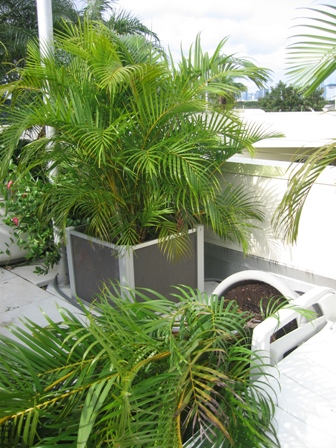
Even light gusts tip tapered planters and pots.
Planter Selection Solutions
All in all, finding lightweight, attractive, large volume planters with drainage control that provide a thermal break with an appropriate design aesthetic in a variety of sizes proved to be impossible, let alone planters that would also stand up to the test of time and the rigors of the property maintenance team.
Existing Solutions
I started landscaping my building in 2004 with the SeaCrest series of large planters from Tournesol Siteworks as a good plastic planter solution but unfortunately they no longer produce it. Every planter available at the time had some compromise, so despite the institutional look imparted by the roto-molded plastic construction, they answered most of the other challenges.
I ordered and installed more than a dozen of the 48” round and 72” rectangular planters for the rooftop, where we were able to engineer in the load capacity to hold their fully wetted weight of at least 2,300 lbs for the cylindrical planter and 1,500 lbs for the rectangular planter. We planted the round planters with 6’ high 3-stem Robellini palms.We planted two Jatropha bushes in the rectangular planters.
While the SeaCrest planters were designed with self-watering reservoirs, we found that it was better to put them on drip irrigation (more about that later), but the double-wall design for the reservoir planter provided just the thermal break that has allowed our plants to thrive despite the baking Miami sun and gave me the idea for my liner-within-a-planter design.
The drainage in the SeaCrest was always iffy. One other issue with the long 72” rectangular planter that arose is that the middle of the planter tends to bulge from the heat of the sun combined with the pressure from the soil, which creates a “creep” in the plastic. I think that “creep” could be a problem for almost any single wall planter made from non-rigid material like plastic, resin, and even fiberglass as the thickness required without a “web” for large planters is cost prohibitive. We have now encased them in our environmentally friendly recycled plastic lumber Mariner planter facades for a modern look.
A New Planter Concept
Since I found that there were really no planters on the market for the balconies and rooftop deck on my project that fit the demanding criteria for large modular planters, I created DeepStream Designs to create commercial planters of a Landscape Architect grade that would meet the complex design criteria I listed above.
I’m not going to recreate the commercial DeepStream Design.com website here, but since a picture is worth a thousand words so you may want to give www.DeepStreamdesign.com site a quick review so that the information below has some context. You may notice that at this point I have only designed rectilinear forms.
Ultimately, to create planters with the large surface area and aesthetics that I was looking for, along with an unlimited variety of dimensions and materials, I had to create two different planter systems: The Mariner Planter for the special challenges of wood and the Audubon Planter that allows planters to be constructed using any other material suitable for outdoor use. Both designs rely on the science and engineering of DeepStream’s “Liner within a Planter” concept for the ultimate health of the plantings, while providing the lowest life-cycle cost for the planters.
Mariner Wood Planters
Designed exclusively to overcome the challenges of constructing wood planters that will last decades while showcasing my favorite material. This is a modular system that allows the wood to expand and contract within the slot of a heavyweight marine anodized aluminum leg without destroying the structural integrity of the planter box. The planking is free to expand, but held at the ends by the legs.
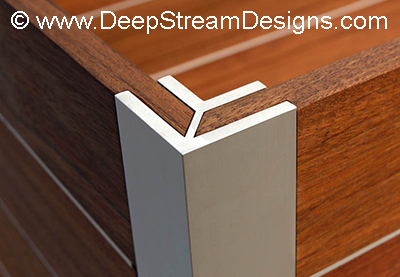
Mariner wood planters constructed with DeepStream’s proprietary aluminum extrusions allow for many custom options such as Restaurant Planters with Windscreen or Garden Planters for Privacy, that incorporate features not available for other planter types.
Audubon Planters
DeepStream’s unique modular frame system that allows planters, or façade systems of any size, to be made from panels of any suitable material.
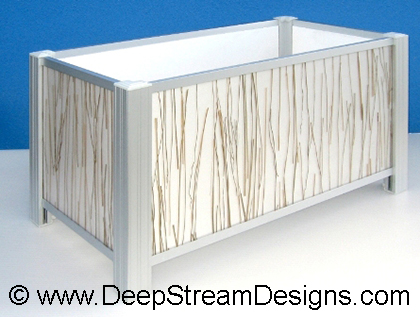
Modern Planter with 3Form Bear Grass UV filtered resin panels
DeepStream’s unique frame system allows the use of any appropriate material
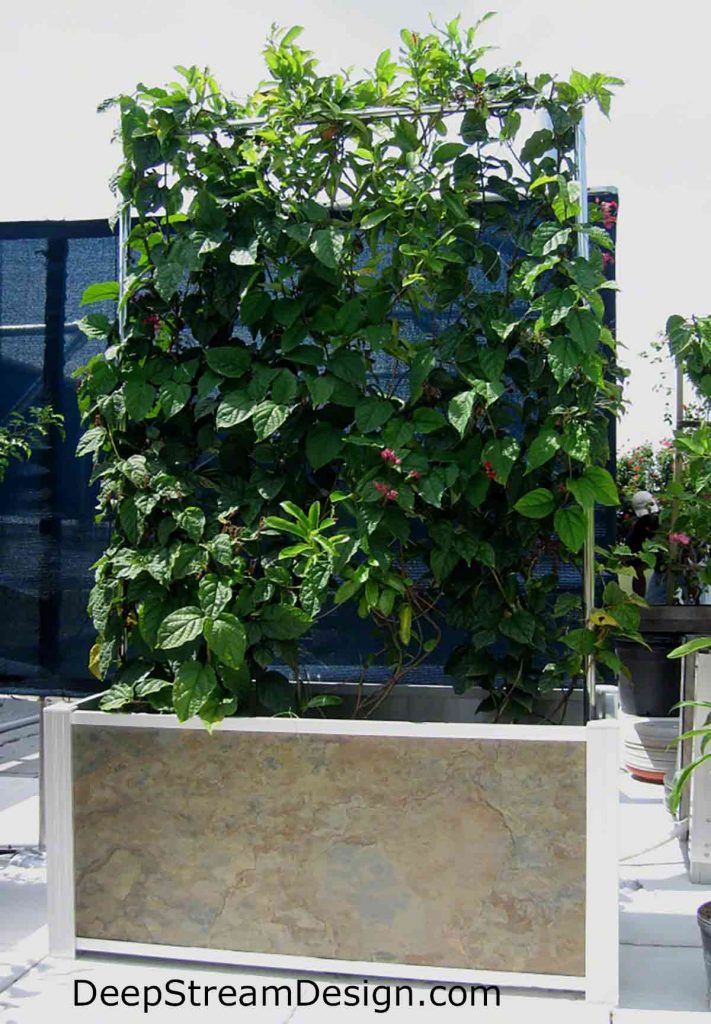

Copper or any appropriate metal or laminate can be used.
Shared Design Features
In theory, only the length of available wood planks for Mariner planters and panel material for the Audubon planters would limit planter size; however, with intermediary legs, the size of either system can be expanded to infinity with DeepStream’s modular prefabricated multi-section commercial planters.
In practicality, the size of a single Mariner or Audubon planter box is limited to 72” in any one horizontal dimension. Dimensions over 72” require that a planter box become a facade that hides a planter liner, or a series of liners, which rest their weight on the building instead of being suspended by the planter box legs. Practical considerations include not only available wood plank lengths, or material sheet size and stiffness for the Audubon planter, but also available planter liner sizes and the combined weight of the soil and plantings.
DeepStream’s two-part “Liner within a Planter” design is not only a solution to solar gain and planter longevity, it is also a key component in drainage control while making watering easy, efficient, and attractive. Every liner can be fitted with an optional drainage system that uses a fitting placed through the liner wall about an inch-and-a-half above the bottom, a filter, a valve, and a hose that can be hooked up to a variety of drainage systems.


The threaded drain, fitted to the wall of the planter liner, is more protected from blockage common for bottom-mounted drains. Although seldom required the drain can be fitted with a valve to provides space for water to accumulate in dry periods to reduce water use and promote plant health. It is a water storage space that can be increased by closing the valve during dry seasons or periods of watering restrictions. The valve allows the drain to be opened during heavy rains to prevent dirty water overflowing from the top of the planter. During heavy rains, the rain will wash away filtered water even without a drainage system hooked into the building’s storm drain system.
Rugged Waterproof Liners constructed from food safe, 100% recycled Linear Low Density Polyethylene (LLDPE) are a key component of DeepStream’s planter design. The separate planter liner is a critical design component, providing a thermal break between the planter box, which absorbs solar gain, and the roots, thus ensuring that the soil is never warmer than the ambient air temperature. This design feature is crucial for plant health on rooftops and southern exposures and cannot be overemphasized or duplicated by single wall planters or pots.

Planters with reservoir inserts may be mandated by existing building design in some public areas due to complexities of providing a water source but they are far from an optimum solution. Drip irrigation, with a moisture sensor, timer, and rain sensor, along with DeepStream’s drainage control system, which eliminates drowning the deeper-rooted plants, has proven to be the best way to water plants on our building.
The liner rests on an aluminum frame attached to the aluminum leg, this keeps the edge of the liner below the top of the planter and allows air to circulate and keeps leaves or dirty water from collecting. Drip irrigation lines can be attached to the frame keeping it out of sight and run up to the planter hidden between the liner and the exterior planter box.
The separate waterproof liner also is the key to preventing contact between wet soil, wood, and metal. This design feature ensures greater durability of all materials, thus providing the longest product life, the lowest possible lifecycle cost, and the lowest impact on the environment.

Drip irrigation provides a natural top-down watering of the soil using a combination of drip emitters, spray heads, and misters that are best for simple and complex plantings with roots systems at different soil depths. Drip irrigation systems can be run off a low pressure “rain barrel” or the building’s high-pressure water system. Unlike single wall planters or pots, DeepStream’s two-part “Liner within a Planter” design hides drip irrigation lines that must run visibly up the outside of single wall planters or pots.
Materials
Durability, modular design with replaceable parts, low lifecycle costs, and minimizing impact on the environment all go hand in hand. To ensure that planters are durable enough to last for decades DeepStream manufactures its wood planters using recyclable marine-grade anodized aluminum and stainless steel fasteners assembled with a special dielectric paste to prevent electrolysis between the dissimilar metals. Aluminum is the world most abundant mineral and it also uses the least amount of energy to be recycled.
The feet on DeepStream’s planters keep the wood from the wet deck, preventing rot induced by wood resting in standing water. They are made from HDPE, a recyclable marine plastic that will not scratch decks and will not absorb water. Our planter liners, constructed from Linear Low Density Polyethylene, are made from 100% recycled plastic and recyclable.
Tropical hardwoods have been used for centuries in shipbuilding, dock, boardwalks, railroad ties and other extreme outdoor uses because their oil content makes them insect- and rot-resistant.Even so, these tropical hardwoods are not rot-proof and they can warp, twist, check and split, which to my mind adds character that is missing in today’s mass products. Our system will minimize all these aspects and contains the wood planks in a structural package for decades. If a plank should need replacing, the modular design means any plank or part of the planter can be replaced.
All of our wood is purchased here in the US so that it meets all environmental import source standards. Additionally, for every planter DeepStream sells, regardless of the construction materials, we plants 50 trees in Brazil.This is done in the name of the customer through a donation to Trees for the Future. With that being said we encourage you to specify recycled plastic lumber instead as even certified wood has likely been “green-washed” and the depletion of the tropical rainforests is leading climate change.
Recycled Plastic Lumber (RPL) In keeping with our mantra “Reduce, Reuse, Recycle,” DeepStream has been offering Commercial Planters & Recyclers built with HDPE planks made from recycled milk jugs.
We stock 5 colors of this Green material and it is growing into a major part of our business due to its low maintenance and the 50 year warranty by its manufacturer. Unlike wood RPL is non-structural and DeepStream has pioneered special construction methods to ensure that structural integrity of large planters is maintained. For more information on how Recycled Plastic Lumber makes a Planter Green read this article.


Almost any other materials can be used in the Audubon Planter system and each has its own characteristics, longevity curves and environmental impact.For instance, there are fantastic looks in new UV-resistant resins from 3form and Reynolds Polymer, just to name a few, that use natural material in the design and can be recycled. The primary laminate backing material for translucent resins is recycled and recyclable expanded PVC.
Tried and true marble or stone of any type, which can last for centuries, is given a new twist when we laminate it to ultra-stiff lightweight honeycomb aircraft aluminum panels so that a 42” planter box is lighter than wood, weighing in at about 52 pounds instead of hundreds of pounds. This allows marble planters, even with 18” of soil, to be used on a balcony or roof project. Even our largest 72” Mariner wood planter weighs only 112 pounds with a 16-pound liner. All of our planters can be shipped assembled and still go up an elevator or stairway easily, or they can be shipped flat and assembled in about 20 minutes with a Phillips head screwdriver.
Stability in high winds is a function of form, height and leverage.In high-wind situations, a square planter has better stability than a rectangular one, and a low planter has better stability than a high one. Of course, a low bush is going to impart less leverage than a tall thick clump of bamboo, while a high palm may allow the wind to just blow through.
Planter Dimension Considerations, although we often get requests for high planters our standard leg heights are 21″, 31″, and 42″ plus a 1/2″ for the foot. This height allows for the standard height of the liner to accommodate 16-17” of soil, plenty for most plantings, while keeping the center of mass low. Aesthetically, it also allows the plant to be the focus of attention, instead of creating a wall of top-heavy looking planters. Lower heights also keeps costs down. If the intention in adding height is to screen a large space, our modular design includes a trellis accessory that combines rugged aluminum uprights and rustproof stainless steel mesh that will stand up to hurricane force winds, yet is not top-heavy.
Here in Florida, it is not possible to bring all the planters in off our large roof deck when a hurricane approaches. We have clips that can be mounted to the fasteners that hold the feet in the legs thus allowing the planter to be bolted to the deck. Many people, however, want to have the ability to move them about, or have rules or conditions that do not allow them to be bolted down so in extreme winds they may be blown over.
Because of these hurricane conditions, I have designed the planter liner to rest on aluminum straps suspended within the planter box. These not only ensure there is no funky accumulation of dirt or water to soil the deck under a planter, but if a planter should blow over and the planter liner blow out, the planter will not sail off the roof as it would if it had a solid bottom.
Call Sheila at DeepStream Designs, 305-857-0466 for a 32 Point Checklist to ensure that your project is successful and help you solve any technical issues your project may encounter ahead of time.
Additional Resources:
Books
Roof Gardens: History, Design, and Construction
Theodore Osmundson (FASLA)
W.W. Norton & Company, 1999.
“A wonderful resource for large green roofs in general and waterproofing, with a table of information about weights of materials (p. 296).”
Magazines
Fantastic sources of professional landscaping resources:Landscape Architect and Specifier News (www.landscapeonline.com)
Landscape Architecture (magazine of the American Society of Landscape Architects – https://www.asla.org/
Garden Design (www.gardendesign.com)
Drainage
DeepStream Designs Drain Pads with Biobarrier root protection
Variflow Technologies, Inc. (www.Varicore.com) Multi-Flow professional drainage systems with very good information on drainage and preventing blockage using coarse grain sand. Their products are great for large drainage areas.
High-quality GFRC concrete planters
High-quality FRP fiberglass planters

